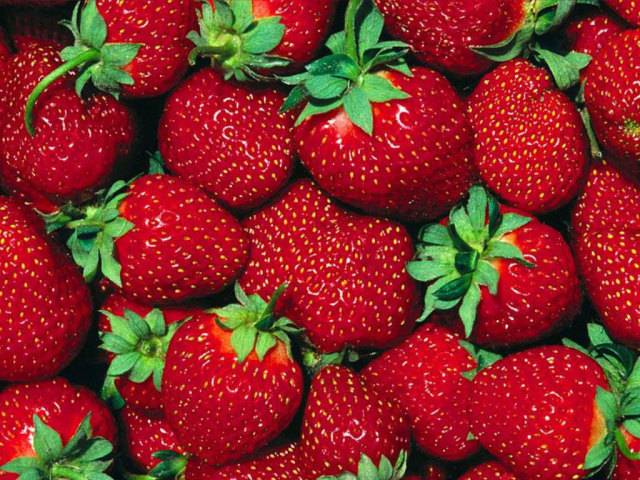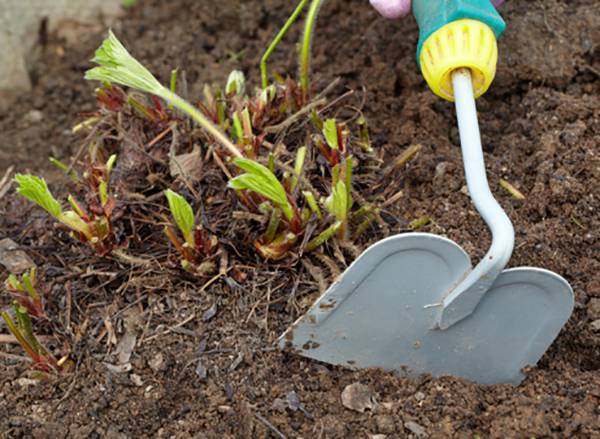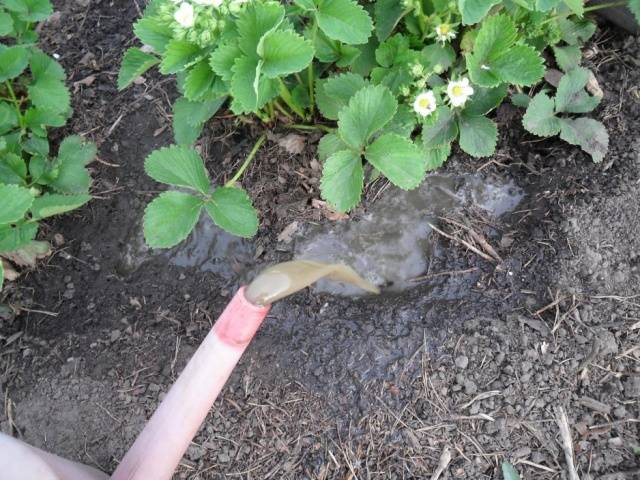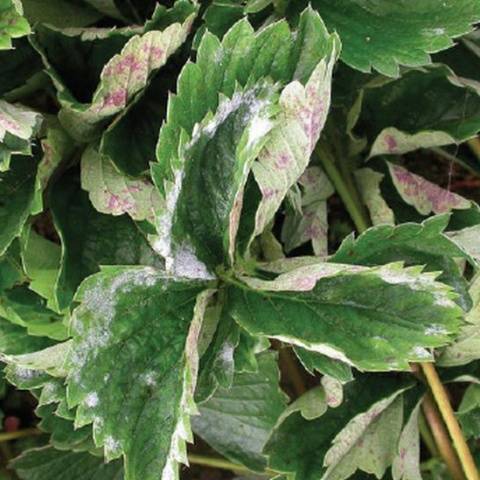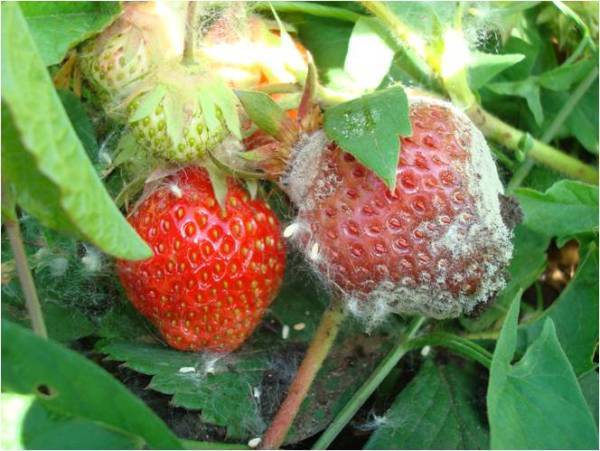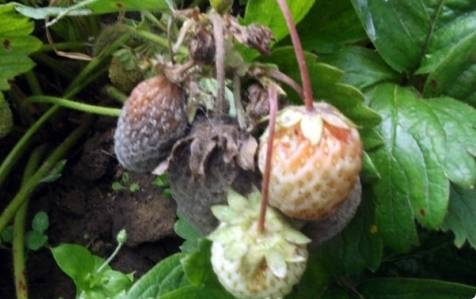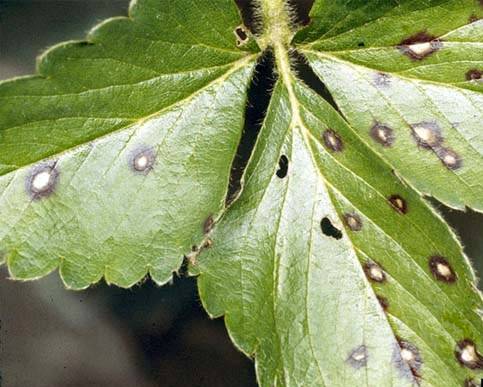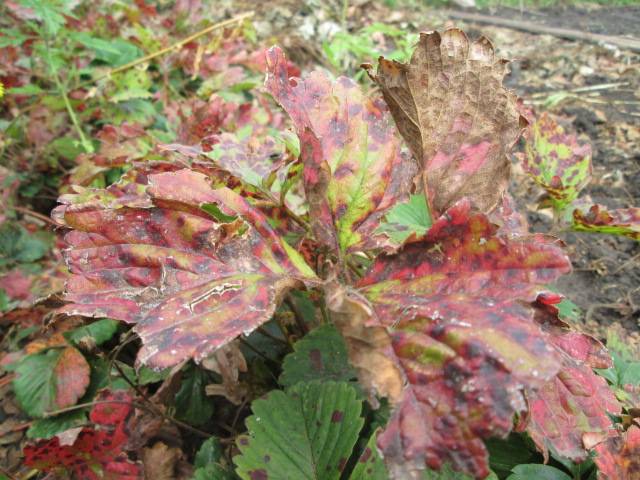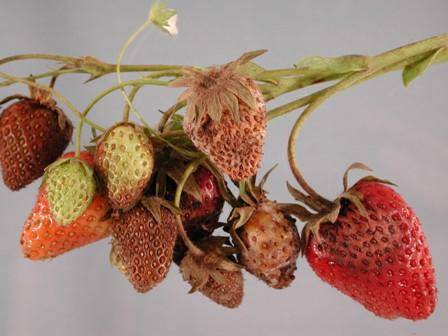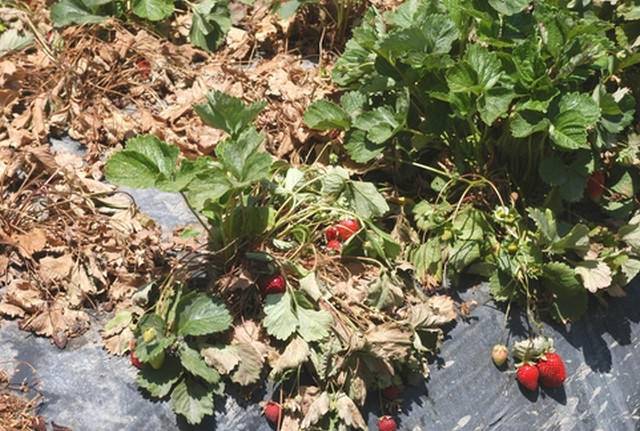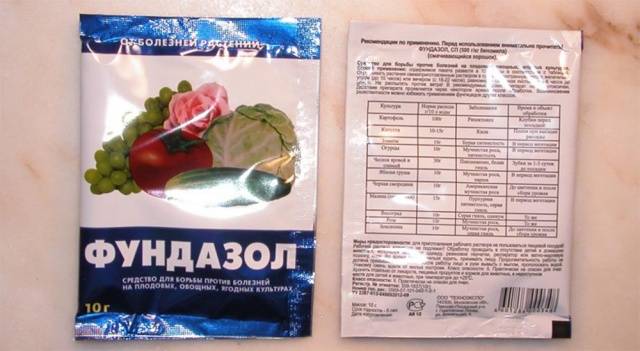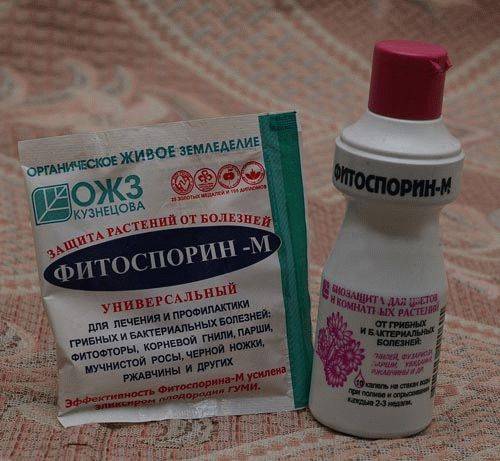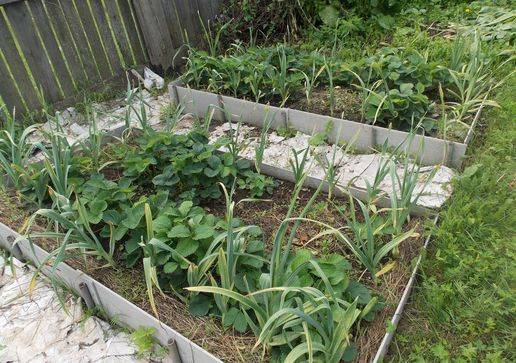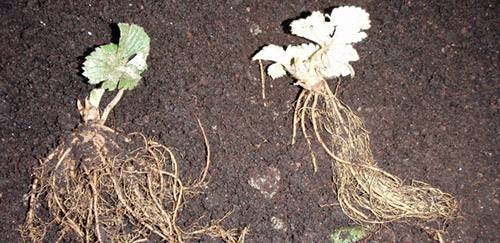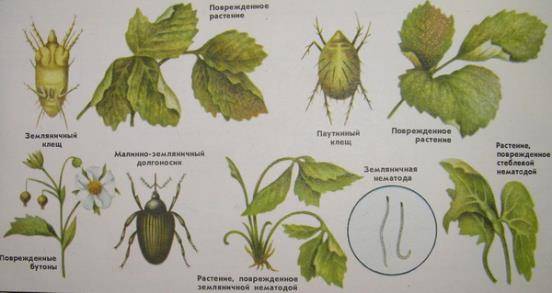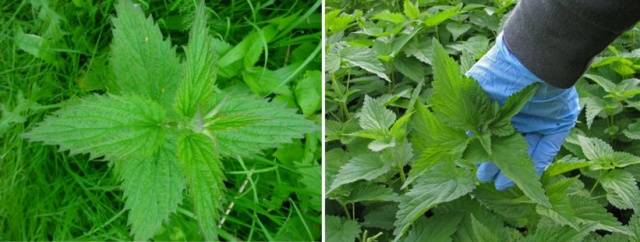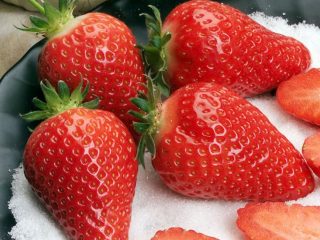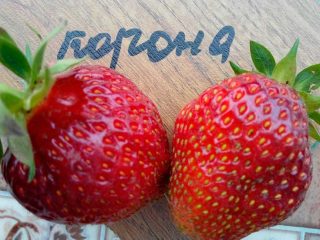Content
In the spring, strawberries begin their growing season and gradually come to their senses after a long winter sleep. Together with her they wake up and pests, which hibernated on bushes and in the soil, various diseases are activated. How to help plants weakened after winter to cope with these troubles? Processing strawberries in early spring is a very important activity that helps plants overcome the effects of winter and throw all their strength into the fastest formation of the crop.
Spring work in strawberry beds
But before processing, you need to put things in order on the strawberry beds, do a general cleaning.
- Remove shelter from strawberry bushes, if any.
- Remove last year's mulch from the beds, it is better to burn it, and not throw it into the compost heap. It can contain many pests and pathogens.
- To clear the strawberry bushes from dried leaves, they not only interfere with the development of plants, but also serve as a refuge for pests and can carry sources of infection. It is better not to pick off the leaves, but to cut them off with a pruner so as not to accidentally pull out the bushes.
- Conduct a revision of overwintered plants, removing diseased and dead ones.
- To plant reserve strawberry bushes, formed from the daughter outlets of the last year, on the vacated places. When planting bushes, first spill the planting holes with a solution of phytosporin, prepared from 10 g of powder and 10 liters of non-hot water, insist for 2 hours in the shade. You need 0.5 liters of solution per well. Treatment with Fitosporin destroys pathogens of fungal diseases.
- Remove or transplant excess strawberry plants to another bed so that the plantings are not thickened.
Each strawberry bush requires a certain area of nutrition. If the distance between the bushes is less than required for a given variety, this will inevitably affect the quality of the crop and reduce its quantity. - An important event is loosening the soil near the strawberries to a shallow depth. Under the influence of melt water, the soil in strawberry beds is compacted, which impairs the supply of air to the roots, which is also necessary for the development of beneficial soil microorganisms. Lack of oxygen reduces soil fertility. Loosening will help the soil warm up faster. If strawberry bushes have bare roots, they need to be earthed.
- After winter, the first thing that begins to grow in strawberries is young leaves. A sufficient number of leaves through the process of photosynthesis helps to feed the flowers and young ovaries. Therefore, it is so necessary feed the strawberries in early spring.
Spring feeding of strawberries
Young bushes have enough nutrition, laid down during planting.
But two-year-old, and even more so three-year-old strawberry plants need nutrition for development.
If its quantity is insufficient, there will be a shortage of harvest. Oddly enough, but the same result will be with excessive nutrition, especially with a predominance of nitrogen fertilizers.
If there is too much nitrogen, strawberries will begin to build up a leaf mass to the detriment of flowering and fruiting. With what feed the strawberries in early spring? Each type of fertilizer - organic or mineral - has its own advantages.
Mineral fertilizers usually contain macro and microelements in the form available to the plant, so they quickly enter them, but also quickly wash out into the lower soil layers during irrigation or rain.
Organic fertilizers contain the same nutrients as mineral fertilizers, but in order to transform into a form accessible to plants, organic substances take time to decompose. When organic matter decomposes, a lot of carbon dioxide is released, which is so necessary for strawberries for good development. Manure, humus, chicken droppings contain microorganisms necessary for the soil to improve fertility. Mineral fertilizers do not have this feature.
If the soil is poor, it is better to choose organic fertilizing, but enrich it with ash and superphosphate.
The scheme for feeding strawberries in spring is as follows:
- A special complex fertilizer for berry crops or intended specifically for strawberries is applied according to the norms in a dry form directly under the bushes, followed by loosening, provided that there is enough moisture in the soil. If there was little snow in winter, and the ground was already dry, it is better to combine feeding strawberries with watering and apply a fertilizer solution under the bushes. It is bred according to the instructions on the package and fed in accordance with it.
- A solution of a fermented mullein is suitable as an organic matter. Half the volume of fresh cow dung is placed in the bucket. Pour it with water and let it ferment. For this amount, you can add a quarter liter of ash and 60 g of superphosphate. After 1-2 weeks, the fertilizer is ready for use. When feeding, 1 liter of solution is added to 7-9 liters of water. Consumption - 10 liters per sq. m. Poultry droppings should be diluted in a proportion of 1 part to 10 parts of water for fresh and twice as much water for dry. He doesn't need to wander. When feeding for 9 liters of water, add 1 liter of solution.
Preventive treatment of strawberry plantation
Spring processing of strawberries is an important event and should not be neglected, especially if there were signs of disease or the spread of pests in the past season.
Very little time is allotted for the preventive treatment of strawberries, since it begins to bloom already in May, and during flowering and, especially, fruiting, it is undesirable to use chemical remedies.
Strawberries, like all other plants, have their own diseases, of which there are about 20 and are affected by pests. Proper processing of strawberries in the spring requires certain knowledge and ability to understand the signs of various diseases.
Strawberry diseases
Many diseases in strawberries are caused by fungal microorganisms.
Powdery mildew
A disease that develops most rapidly with high humidity and weak air circulation. Powdery mildew signs: white blotch on all parts of the plant. Begins Disease from petioles and quickly captures the entire bush. The spores of the fungus are transmitted from plant to plant and can leave the gardener not only without a crop, but also without the strawberry itself. Processing strawberries in spring will help get rid of the powdery mildew pathogen even before fruiting.
Gray rot
The disease manifests itself when berries ripen, they rot, becoming covered with gray mold, which is fungal spores. Strawberries should be processed for this disease in early spring. Affected berries are placed in a separate container and destroyed.
White rot
The disease manifests itself in years with low temperatures and high humidity. The leaves of the strawberry brighten and become covered with a white bloom, the berries rot.The spread of the disease is facilitated by too frequent planting of strawberries and poor weeding of the plantation.
Black rot
The disease affects only strawberries, which become watery and turn black. To prevent the disease, you should not often plant bushes and waterlogging the soil.
Various spots also have a fungal nature: white, brown and black or anthracnose, which at first infect strawberry leaves, covering them with small specks of various colors, and then capture the entire plant as a whole. It begins to lag behind in growth, and you can not talk about getting a harvest.
Fungi also cause late blight or late blight rot of strawberries - a dangerous disease, the result of which is the death of the plant. The berries are affected first, and then the whole plant wilts. Treatment for late blight should be started in early spring, without waiting for the development of the disease.
Fusarium wilting leads to the same result. It manifests itself during the formation of the crop. A distinctive feature is the dark color of the leaves of the plant, which dry out. The disease affects the conductive vessels of strawberries. You cannot help a sick plant. It will have to be burned.
Strawberry vertical wilt
The disease begins in late May and reaches its peak after harvest. Initially, chlorosis appears on the leaves of plants, they begin to lag behind in growth, and their number decreases. A characteristic feature is the red color of the petioles at the end of the strawberry growing season. On light soils, a lightning-fast course of the disease is possible with the death of plants in 3 days; on other soils, the disease lasts longer, but ultimately still leads to the death of the plant.
Therefore, along with the treatments, you should properly water the strawberries and not plant the bushes too densely so that they can be well ventilated.
Preventive spring treatments
Since the vast majority of strawberry diseases are fungal in nature, strawberries will have to be treated in spring with agents that actively fight various fungi.
Chemicals
Best of all, fungal diseases are resisted by preparations containing copper: home, Bordeaux liquid, copper sulfate. You can use systemic fungicides that have a wide spectrum of action. These are Horus, Topaz - which have a 3rd class of danger and Fundazol - a very effective drug, but having a hazard class 2. Foundation treatment should be carried out as early as possible, so that by the time the peduncles are extended, harmful substances have already been removed from the plants.
All these substances are unsafe for humans.
How to process strawberries in order to maintain plant health and grow environmentally friendly berries?
Folk remedies
Perhaps they are less effective, but definitely safer for humans and beneficial insects.
- Fitosporin is a contact microbiological fungicide that fights well against fungal plant infections. A significant drawback - it is quickly washed off by rain and watering, therefore, repeated treatments are required. Fitosporin does not pose a danger to humans; strawberries can be processed at any stage of development.
- Processing strawberries with iodine is a simple but quite effective remedy. Usually, 15 to 20 drops of iodine and a glass of homemade whey are added to a 10 liter bucket. The multiplicity of processing is no more than two every 10 days. This method of processing strawberries is also effective against pests.
- Planting between rows of strawberries, onions and garlic.
The phytoncides of these plants repel strawberry pests and help fight diseases. In addition, it is possible to harvest two crops from one area at once. - Pine needles are poured with an equal volume of boiling water.Insist during the day, dilute five times and spray the berry.
- Processing with horse sorrel infusion. In a plastic bucket, put as much chopped horse sorrel as it will enter, fill it with hot water and let it brew for 7-14 days. Dilute the infusion ten times and water or spray the strawberry bushes.
Horse sorrel contains flavonoids and antibacterial substances that are effective against fungal diseases. This infusion is also good for cabbage caterpillars. - In the spring, it is good to treat the strawberry plantation with hot water. This procedure should be carried out while the air temperature is low, and the snow has not yet melted all. Water with a temperature of 70-80 degrees is poured into a watering can and the plants are watered. When watering, the water cools and does not burn the strawberry bushes, but it destroys pathogens and pests.
Often diseases and pests get to a new place with strawberry planting material. To disinfect it, it is necessary to keep the roots of the seedlings in a phytosporin solution. In 5 liters of water, 10 g of powder is diluted. The solution is kept for 2 hours so that the hay stick, which is the active ingredient of the drug, is activated. The roots of the seedlings must be kept in the solution for 2 hours too. To destroy pests, they can also be kept in water with a temperature of 45 degrees for about a quarter of an hour.
Pests often settle on garden strawberries, which can not only leave the gardener without a crop, but also destroy the entire berry.
Pest control
Nematode
It is difficult to fight nematodes on strawberries. There is no completely effective treatment from them. All the methods used can only reduce their number. It is possible to recommend drugs piperazine and decaris, effective against helminths. But this is a temporary measure, since they only affect adults. They scare away the nematode, but calendula and marigolds do not destroy it. Planted among strawberries, they drive out most of the pests from the site. You can process strawberries and infusion of these plants.
Spring nematode treatment is carried out with a 1% solution of Bordeaux liquid. You can use the drug Phosphamide, which also destroys the tick. The effect of the drug after treatment lasts 20 days.
Folk recipe for nematodes: a bucket of nettle leaves is poured with boiling water. The solution infused for 4 days is poured over the bushes and the ground around them. When processing, you need to ensure that all leaves are wetted with a solution.
Strawberry mite
Of the chemicals, malofos and colloidal sulfur are suitable. But processing with them is possible only at a temperature of at least 15 degrees Celsius, at a lower temperature it is not effective.
The period from processing to harvest can be as little as 3 days.
The drug Neoron is also suitable. It is a contact insecticide effective against all types of mites. It has a 4 hazard class and is not toxic to beneficial insects. Neoron cannot be mixed with other chemicals. The period of the protective action of the drug is up to 20 days.
Fitoverm will also help. It is a biological acaricide and insecticide that not only destroys ticks, but also fights aphids and weevils.
From folk remedies for processing strawberries in spring, an infusion of onion peels is suitable - 200 g per 10 liters. After five days of infusion, the plants are sprayed. Treating plants with infusion of dandelion leaves is also a good and safe way.For 1 kg of fresh leaves (can be replaced with 500 g of roots), you need 10 liters of hot water with a temperature of 50 degrees. The infusion process lasts only 4 hours. With the strained infusion, carefully process the strawberry bushes, not forgetting about the underside of the leaves.
The same measures are applied to protect against spider mites.
Weevil
From chemicals in the spring, Inta-vir is suitable. Biological preparations Iskra-bio and Nemabakt help well.
Folk remedies
Plant onions and garlic on strawberry beds, spread fern leaves under the bushes. There is a very simple way to repel this pest: lightly sprinkle the soil with toothpowder. Ash scattered around the bushes also acts. They do not allow the beetle to carry harmful activity and infusions of hot pepper, tansy and wormwood. The strawberry leaves treated with them are not to the taste of the beetle. 100 g of mustard powder, dissolved in 3 liters of water, is an excellent processing agent.
5 g of potassium permanganate, dissolved in 10 liters of water intended for processing strawberries, will not only scare off the weevil, but also help against gray mold and powdery mildew.
It must be remembered that weakened plants are primarily attacked by pests and diseases. Take proper care of the strawberries, follow all the rules of agricultural technology, take into account the requirements of a particular variety, increase the immunity of plants with the help of immunostimulants and the number of treatments can be reduced.
Conclusion
Spring processing of strawberries from pests and diseases is a guarantee of further plant health and obtaining a decent harvest of delicious berries.
